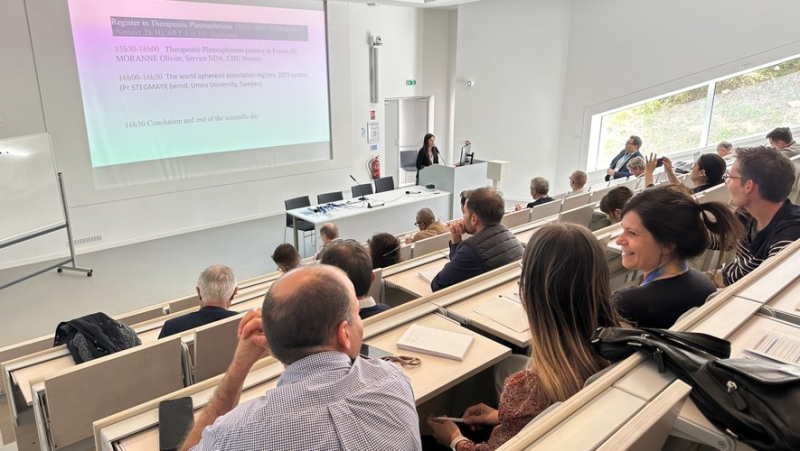International Congress on therapeutic plasmapheresis: in Nîmes, we are trying to discover all the secrets of plasma

For three days, Nîmes became the capital of research into plasma-related treatments. Midi Libre – D.R.
Through the Arenas of Therapeutic Plasmapheresis, Nîmes welcomed the best world specialists in the discipline. The opportunity to better understand, with the head of the nephrology-dialysis-apheresis department of the CHU, Professor Olivier Moranne, what is hidden in our plasma and the problems linked to its dysfunction.
What is therapeutic plasmapheresis?
Plasma is one of the constituents of blood. In the blood, there are two types of components: cells (red blood cells, white blood cells, platelets). Then, we have water with lots of active elements like proteins or cholesterol. This constituent is plasma. It circulates in the body carrying elements necessary for cells. Sometimes, we can have people who are sick because they are missing a substance in the plasma. In this case, we take medication or we call on blood donation to recover plasma from healthy subjects and provide it. Or you may have diseases that involve an abnormality of the plasma. Where constituents are pathological. It will then be necessary to subtract the plasma and process it.
Pathological constituents in what sense ?
We can imagine that, in the plasma, there is a protein that we can call an antibody. In the group of autoimmune pathologies, this antibody will become toxic to our organs. Sometimes our own immune system, which is normally designed to recognize us and recognize foreign bodies and attack them, will undergo a change in the program and turn against us. In this situation, for rare diseases, we will do plasmapheresis. That is to say that we will treat the plasma to modify it.
What types of diseases can be linked to these pathogenic elements ?
All so-called autoimmune diseases, including many neurological diseases which can sometimes give rise to acute paralysis. Like Guillain-Barré syndrome, where patients find themselves paralyzed within two weeks because the plasma, overnight, begins to contain a pathogenic substance. We also find vasculitis, where antibodies begin to attack blood vessels. These pathologies are rare, but will require plasma treatment. Gradually, drugs are being developed that can reverse the effect of these proteins. But as an initial treatment, we can offer plasmapheresis.
We also have diseases linked to hypercholesterolemia. We can have bad cholesterol in our blood because of our diet. But we also have people who are born with genetic diseases that create excess cholesterol in the plasma. In this case, we can act with medication or, if this is not sufficient, clean the blood by plasmapheresis, by removing all of the plasma and replacing it with healthy plasma, or by just targeting the identified protein. But these remain heavy devices, because they require extracorporeal circulation, where we will take the blood out of your body, treat it with filters before reinjecting it.
An international congress has just ended at the Montpellier-Nîmes faculty of medicine. Why in Nîmes and what goal?
I have been a researcher and teacher in the nephrology department at the University Hospital in Nîmes for 8 years and it is an area of expertise that I have developed. We are an expert center. If patients are not treated in Nîmes, they must go to Marseille or Montpellier. We have a very large activity, because we recruit patients from all over Gard, but also from Arles or Vaucluse to avoid the patient having to go too far from home. As part of a faculty university scientific activity, when we develop techniques that are rare on niche themes, to increase the quality of care, we work on international exchanges. We must be open to practices carried out abroad to multiply reasoning, approaches and improve. This congress, which began nationally five years ago, is the only one of its type in Europe. We notably received a person from San Diego, which is the largest center in the United States. Singapore was also present. The idea is that everyone makes presentations on topics and debates follow.
Do you think today that plasma has revealed all its secrets?
No! We still have lots of things to discover! Both on plasma and on the treatments available. So much so that we have ancestral treatments that we still don’t really understand how they work. That is, we know that by treating the plasma, the patient's condition improves, but we do not know what the pathogen is. . Afterwards, these are things that we see regularly in medicine.
In summary, sometimes you know that therapeutic plasmapheresis works, but not why it works.
That's exactly it. But the most important thing is that it works. And this still gives us room for research!
Hence the importance of donating blood.
It’s very important, we can never emphasize it enough. There is a shortage of blood donors. You must donate, whether whole blood, platelets or plasma. And if you want a scoop, when you donate, you also donate white blood cells. Which are today the source of a great therapeutic innovation whose history comes from plasmapheresis and blood donation.
What is this therapeutic innovation ?
In the field of cancer, we now have new treatments where we reprogram your white blood cells against your cancer cells. This is what we call cell therapy: we take your blood cells, we take your cancer cells, we look at the signature of the cancer cell in order to program your white blood cells against these cells. Then they are reinjected into you and they will destroy your cancer cells. This is the therapeutic break. We are here on the treatments of tomorrow.




